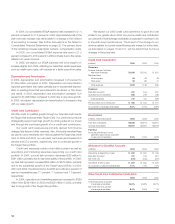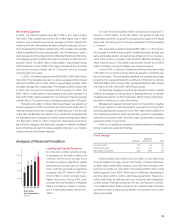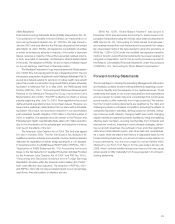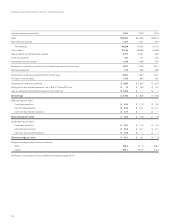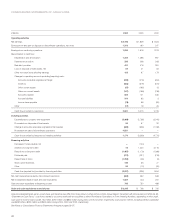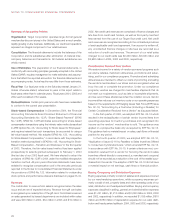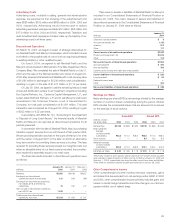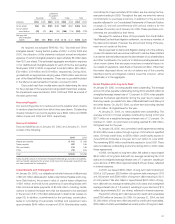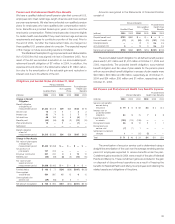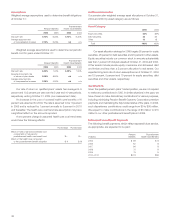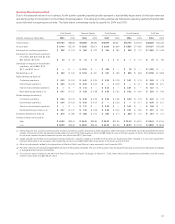Target 2004 Annual Report Download - page 30
Download and view the complete annual report
Please find page 30 of the 2004 Target annual report below. You can navigate through the pages in the report by either clicking on the pages listed below, or by using the keyword search tool below to find specific information within the annual report.
28
Summary of Accounting Policies
Organization Target Corporation operates large-format general
merchandise discount stores in the United States and a much smaller,
rapidly growing on-line business. Additionally, our credit card operations
represent an integral component of our retail business.
Consolidation The financial statements include the balances of the
Corporation and its subsidiaries after elimination of material inter-
company balances and transactions. All material subsidiaries are
wholly owned.
Use of Estimates The preparation of our financial statements, in
conformity with accounting principles generally accepted in the United
States (GAAP), requires management to make estimates and assump-
tions that affect the reported amounts in the financial statements and
accompanying notes. Actual results may differ from those estimates.
Fiscal Year Our fiscal year ends on the Saturday nearest January 31.
Unless otherwise stated, references to years in this report relate to
fiscal years rather than to calendar years. Fiscal years 2004, 2003 and
2002 each consisted of 52 weeks.
Reclassifications Certain prior year amounts have been reclassified
to conform to the current year presentation.
Stock-based Compensation In December 2004, the Financial
Accounting Standards Board finalized Statement of Financial
Accounting Standards No. 123R, “Share-Based Payment” (SFAS
No. 123R). SFAS No. 123R eliminates accounting for share-based
compensation transactions using the intrinsic value method prescribed
in APB Opinion No. 25, “Accounting for Stock Issued to Employees,”
and requires instead that such transactions be accounted for using a
fair-value-based method. We adopted SFAS No. 123, “Accounting
for Stock-Based Compensation,” in accordance with the prospective
transition method prescribed in SFAS No.148, “Accounting for Stock-
Based Compensation – Transition and Disclosure” in the first quarter
of 2003. Therefore, the fair value based method has been applied
prospectively to awards granted subsequent to February 1, 2003
(the last day of our 2002 fiscal year). We have elected to adopt the
provisions of SFAS No.123R in 2004 under the modified retrospective
transition method. All prior period financial statements have been
restated to recognize compensation cost in the amounts previously
reported in the Notes to Consolidated Financial Statements under
the provisions of SFAS No. 123. Information related to outstanding
stock options and performance shares is disclosed on pages 33-34.
Revenues
The contribution to revenue from sales is recognized when the sales
occur and are net of expected returns. Revenue from gift card sales
is recognized upon redemption of the gift card. Commissions earned
on sales generated by leased departments are included within sales
and were $46 million in 2004, $32 million in 2003 and $19 million in
2002. Net credit card revenues are comprised of finance charges and
late fees from credit card holders, as well as third-party merchant
fees earned from the use of our Target Visa credit card. Net credit
card revenues are recognized according to the contractual provisions
of each applicable credit card agreement. If an account is written-off,
any uncollected finance charges or late fees are recorded as a
reduction of credit card revenue. The amount of our retail sales
charged to our credit cards was $3,269 million, $3,006 million and
$2,980 million in 2004, 2003 and 2002, respectively.
Consideration Received from Vendors
We receive income for a variety of vendor-sponsored programs such
as volume rebates, markdown allowances, promotions and adver-
tising, and for our compliance programs. Promotional and advertising
allowances are intended to offset our costs of promoting and selling
the vendor’s merchandise in our stores and are recognized when we
incur the cost or complete the promotion. Under our compliance
programs, vendors are charged for merchandise shipments that do
not meet our requirements, such as late or incomplete shipments,
and we record these allowances when the violation occurs. Vendor
income either reduces our inventory costs or our operating expenses
based on the requirements of Emerging Issues Task Force (EITF) Issue
No. 02-16, “Accounting by a Customer (Including a Reseller) for
Certain Consideration Received from a Vendor” as discussed below.
In the first quarter of 2003, we adopted EITF No. 02-16 which
resulted in the reclassification of certain vendor income items from
operating expenses to inventory purchases and recognized into
income as the vendors’ merchandise is sold. The guidance was
applied on a prospective basis only as required by EITF No. 02-16.
This guidance had no material impact on sales, cash flows or financial
position for any period.
In the fourth quarter of 2003, we adopted EITF No. 03-10,
“Application of Issue 02-16 by Resellers to Sales Incentives Offered
to Consumers by Manufacturers,” which amends EITF No. 02-16.
In accordance with EITF No. 03-10, if certain criteria are met, con-
sideration received from a vendor for honoring the vendor’s sales
incentives offered directly to consumers (i.e. manufacturer’s coupons)
should not be recorded as a reduction of the cost of the reseller’s pur-
chases from the vendor. The adoption of EITF No. 03-10 did not have
a material impact on net earnings, cash flows or financial position.
Buying, Occupancy and Distribution Expenses
Buying expenses primarily consist of salaries and expenses incurred
by our merchandising operations, while occupancy expenses pri-
marily consist of rent, property taxes and other operating costs of our
retail, distribution and headquarters facilities. Buying and occupancy
expenses classified in selling, general and administrative expenses
were $1,421 million, $1,213 million and $1,063 million in 2004, 2003
and 2002, respectively. In addition, we recorded $1,035 million, $910
million and $789 million of depreciation expense for our retail, distri-
bution and headquarters facilities in 2004, 2003 and 2002, respectively.
NOTES TO CONSOLIDATED FINANCIAL STATEMENTS


